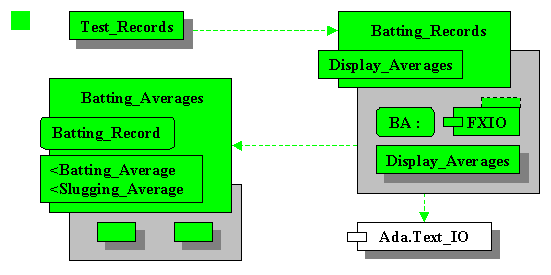-----------------------------------------------------------
-------------------- Batting_Averages --------------------
-- This package exports a record type holding the batting
-- data for a specific player in a specific year, a fixed-
-- point type and two functions. The functions are used
-- for computing batting average (Hits per At_Bats) and
-- slugging average (Total_Bases per At_Bats).
-----------------------------------------------------------
package Batting_Averages is
type String_14 is array (1..14) of Character;
type Batting_Record is -- start record type declaration
record
Name : String_14;
Year : Natural;
At_Bats : Natural;
Singles : Natural;
Doubles : Natural;
Triples : Natural;
Home_Runs : Natural;
end record; -- finish declaration
type Batting_Average_Type is delta 0.001 range 0.000 .. 4.000;
function Batting_Average(BR : Batting_Record)
return Batting_Average_Type;
function Slugging_Average(BR : Batting_Record)
return Batting_Average_Type;
end Batting_Averages;
----------------------------------------------------------
package body Batting_Averages is
---------------------------------------------
function Batting_Average(BR : Batting_Record)
return Batting_Average_Type is
Hits : Natural;
BA_FL : Float;
begin
Hits := BR.Singles + BR.Doubles
+ BR.Triples + BR.Home_Runs;
BA_FL := Float(Hits)/Float(BR.At_Bats); -- 2 type conversions
return Batting_Average_Type(BA_FL); -- 1 type conversion
end Batting_Average;
----------------------------------------------
function Slugging_Average(BR : Batting_Record)
return Batting_Average_Type is
Total_Bases : Natural;
SL_FL : Float;
begin
Total_Bases := BR.Singles + 2*BR.Doubles
+ 3*BR.Triples + 4*BR.Home_Runs;
SL_FL := Float(Total_Bases)/Float(BR.At_Bats);-- 2 type conversions
return Batting_Average_Type(SL_FL); -- 1 type conversion
end Slugging_Average;
------------------------------------------------
end Batting_Averages;
----------------------------------------------------------
----------------------------------------------------------
-------------------- Batting_Records --------------------
-- This package exports a procedure to display a set of
-- batting and slugging averages. In its body it creates
-- an array of batting records and an instance of the
-- generic package Fixed_IO, exported by Ada.Text_IO.
----------------------------------------------------------
package Batting_Records is
procedure Display_Averages;
end Batting_Records;
----------------------------------------------------------
with Ada.Text_IO; use Ada.Text_IO;
with Batting_Averages; -- array of records
use type Batting_Averages.Batting_Record -- use type clause
package body Batting_Records is
BA : array (1..5) of Batting_Record
:= (("Albert Belle ",1998,609,101,48,2,49),
("Ken Griffey ",1998,633, 88,33,3,56),
("Mark McGuire ",1998,509, 61,21,0,70),
("Sammy Sosa ",1998,643,112,21,0,66),
("Greg Vaughn ",1998,573, 78,28,4,50));
package FXIO is new Fixed_IO(Batting_Average_Type);
-------------------------------------------------------
procedure Display_Averages is
begin
Put_Line(" Name Year Batting Slugging");
Put_Line(" Average Average");
New_Line;
for I in 1..5 loop
Put(String(BA(I).Name) & Natural'Image(BA(I).Year));
Put(" ");
FXIO.Put(Batting_Average(BA(I)));
Put(" ");
FXIO.Put(Slugging_Average(BA(I)));
New_Line;
end loop;
end Display_Averages;
------------------------------------------------
end Batting_Records;
----------------------------------------------------------
----------------------------------------------------------
---------------------- Test_Records ---------------------
-- This test procedure simply makes a procedure call
-- to Display_Averages.
----------------------------------------------------------
with Batting_Records;
procedure Test_Records is
begin
Batting_Records.Display_Averages;
end Test_Records;
--------------------------------------------------
|
